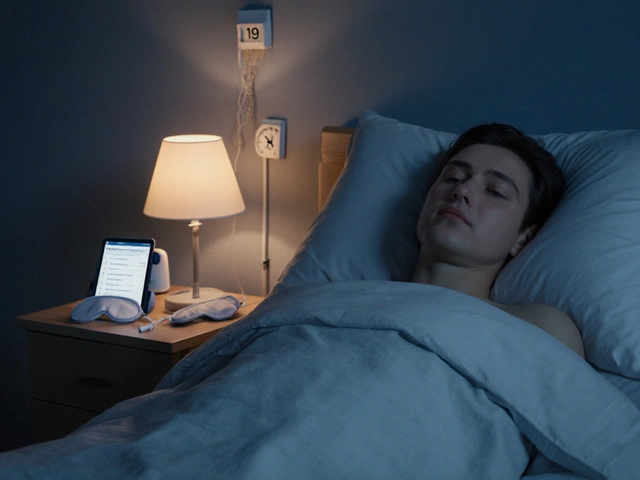Most people don’t plan to learn everything about an antidepressant until they or someone they love is handed a prescription. Yet, the minute a doctor mentions Venlor—also known as venlafaxine—the questions rush in. Is it safe? What really happens to your body and mind? Does it actually work for depression and anxiety or just add strange side effects to your life? Whether you’ve seen Venlor sitting in a medicine cabinet, heard someone vent about their withdrawal woes, or you’re quietly Googling at 3 a.m., you’re not the only one curious. The world’s use of antidepressants like Venlor has spiked in the last ten years, which means understanding this medicine is more personal and practical than ever before.
What Is Venlor, and How Does It Work?
The name Venlor might sound mysterious, but it’s really just a brand name for venlafaxine, an antidepressant that’s been around since the mid-1990s. Venlor sits in a medication class called SNRIs—serotonin-norepinephrine reuptake inhibitors. Basically, it plays with brain chemistry by helping the brain’s feel-good chemicals, serotonin and norepinephrine, stick around longer between nerve cells. That sounds simple, but those few extra molecules floating between your brain cells can make a massive difference for people battling major depressive disorder or certain types of anxiety, like generalized anxiety disorder and social phobia.
One interesting fact: venlafaxine started out as a "cleaner" version of antidepressants compared to older drugs. Doctors noticed that some people who didn’t respond to SSRIs (like fluoxetine, the ingredient in Prozac) actually started feeling better on Venlor. Why? Partly because Venlor doesn’t just focus on serotonin. By nudging both serotonin and norepinephrine, Venlor covers more ground—think of it as a two-pronged approach to the low moods and energy dips that come with depression and anxiety.
The starter dose for Venlor is usually around 37.5 mg, but people end up anywhere from 75 mg up to 225 mg or more, split over the day. Extended-release tablets have made life so much easier—no need to remember pills every few hours. Some people notice little to no effect in the first week. That’s normal. Most folks start seeing changes within two to four weeks, but don’t expect instant results. The brain simply doesn’t turn on a dime. A tip for anyone just starting? Track your mood on paper for the first month and bring notes to your next doctor visit. You’ll notice changes that you otherwise might miss in the blur of everyday life.
Venlor is also prescribed for off-label uses like panic disorder, and, at times, neuropathic pain. This versatility makes it a favorite for doctors, but also muddy for patients—why does one prescription tackle so many issues? It’s all down to those brain chemicals. Serotonin and norepinephrine do way more than influence sadness; they play into energy, motivation, sleep, and pain response.
Who Takes Venlor? Real-Life Stories and Cautions
The list of people prescribed Venlor keeps getting longer every year. Classic candidates are adults with major depressive disorder, but now doctors reach for Venlor for teens (with major caution and monitoring) and for older adults who haven’t responded to other medications. If you browse Reddit or online forums, you’ll find stories from college students wrestling with anxiety, parents attempting to function again after losing a loved one, and people with chronic pain who tried antidepressants after painkillers made things worse.
But who shouldn’t take Venlor? Anyone with a recent history of heart trouble, uncontrolled high blood pressure, or a tendency for manic episodes needs a doctor’s thorough review before even starting. There’s a documented risk: Venlor can slightly bump blood pressure as doses go up. That’s no joke for someone already prone to hypertension. Also, people with liver or kidney disease sometimes need a dose adjustment—Venlor is processed by both organs, and build-up can get real if things are lagging behind the scenes. One often-overlooked fact is how Venlor might mess with sexual function, especially at higher doses, which sometimes feels like trading depression for a totally different kind of frustration. Worth flagging at a doctor’s visit, awkward or not.
Pregnancy and breastfeeding raise another set of questions—doctors typically avoid prescribing Venlor during pregnancy unless the risk of not treating depression outweighs the potential risk to the fetus. There have been rare reports of withdrawal in newborns exposed during late pregnancy, and the drug does pass into breast milk (usually in small amounts). It’s a gray area, so anyone in that boat needs one-on-one guidance from their doctor.
One story that sticks with me is a young woman who’d tried everything for chronic depression—three different SSRIs, long walks, meditation, supplements. Venlor, at 75 mg, finally gave her back her mornings. But her sister tried it for anxiety and got slammed with nausea for a week, then nothing. Two people, same medication, totally different rides. It’s part science, part body chemistry lottery. If you know someone on Venlor, don’t assume their experience matches yours or what’s written in the medication leaflet.

Common Side Effects and How to Handle Them
Let’s cut to the chase—Venlor’s side effects can be a dealbreaker, especially for the first timers. Nausea tops the list. In studies, almost 1 in 3 people reports feeling queasy during the first week. Some get headaches or a jittery, on-edge feeling like they’ve had too much coffee. Dry mouth, sweating (especially night sweats), and loss of appetite crop up pretty often, too. Most side effects fade after two to three weeks, but not always. If you can survive that first stretch, your odds of sticking with Venlor get a lot better.
Some people mention that taking Venlor with food, or right after eating, makes all the difference for their stomach. A full glass of water helps, too. Those who struggle with sleep sometimes find that switching the pill to morning makes night rest easier, while folks with drowsiness try it in the evening. It’s personal, but small adjustments like this can salvage a medication that otherwise feels impossible to continue.
Sexual side effects—low libido, trouble reaching orgasm, or erectile dysfunction—can show up, especially as doses climb past 150 mg. Most people don’t bring it up at first, but it's one of the more common reasons people stop the medication. If it happens to you, you’re not alone, and there are sometimes workarounds, like dose adjustments or even a medication "vacation" under doctor supervision, though that needs careful handling. Don’t try changes on your own; always loop your doctor in.
The rare but more serious stuff? Watch for blood pressure changes (ask your doctor to check it at each visit), and any new bruising or bleeding, which means the medication may be playing with platelets. In very rare cases, Venlor can contribute to a dangerous spike in serotonin—"serotonin syndrome." That looks like confusion, rigid muscles, racing heart, and vomiting. Rush to the ER if that ever happens.
On the upside, recent studies show Venlor doesn’t tend to cause much weight gain, and sometimes people actually lose a little weight at the beginning. If weight loss is sudden or extreme, though, it’s time for a check-in.
Tips for Starting, Staying On, and Stopping Venlor
If you’re just starting Venlor, patience is your best friend. Most people don’t feel much in the first week, aside from maybe that annoying nausea. Try to stick with it for at least four to six weeks—unless side effects are unbearable—before deciding if it’s helping.
Set yourself up for success: Set reminders for your medication. Skipping doses on Venlor can lead to some pulling-your-hair-out withdrawal symptoms. Known as "discontinuation syndrome," this can bring on dizziness, flu-like aches, weird electric shock sensations (yes, really—people call them "brain zaps"), and sudden mood swings. That’s why Venlor is never something to quit cold turkey. Tapering off usually means stepping down by 37.5 mg at a time, sometimes over weeks or even months, depending on your dose and how you react. Always talk it through with your prescriber before changes.
If you’re the type who’s already on other drugs, watch out for interactions. Venlor has a decently long list, but if you take triptans for migraines, certain antibiotics, or St. John’s Wort supplements, be upfront with your doctor. Mixing meds that all boost serotonin ups your risk, and sometimes it’s the combination that sneaks up on you instead of a high dose of any single medication.
Many people, after months or years on Venlor, decide it’s time to move on—maybe their depression is more manageable now, maybe side effects become too much, or maybe pregnancy is on the horizon. Don’t rush it. Set a check-in schedule with your doctor and stick to it. Journaling your mood, sleep, and any weird symptoms helps catch problems early. If you’re ever unsure, don’t tweak the dose yourself—a hasty adjustment can leave you feeling way worse than you started.
Curious about lifestyle changes that help while on Venlor? Exercise, consistent sleep schedules, and non-caffeinated hydration can help buffer some side effects, especially jitteriness or insomnia. A small 2022 study found that people who paired Venlor with basic cognitive behavioral therapy did better than those on medication alone. So, think of medicine as part of the toolbox, not the whole kit.

Living Well with Venlor: What Most People Wish They Knew
Here’s one thing most online info misses: Life on Venlor doesn’t mean your personality gets erased or you suddenly walk around in a numb haze. Actually, if the dose fits and depression lifts, people often describe feeling more "like themselves" for the first time in months or years. Energy comes back, small joys matter again, and even the color in nature looks sharper. Sure, there are outliers—some people feel emotionally dulled and decide Venlor just isn’t for them. That’s a valid reason to look at alternatives.
Routine lab work is rarely required with Venlor unless you’re on it for years or taking other complicated medications. That said, tracking blood pressure at home makes sense if you’re on a higher dose. Most pharmacies now stock affordable home monitors, and some insurance plans cover them. It’s worth ten seconds a week to catch any issues early.
Support from friends or family speeds up recovery. The stigma around antidepressants is melting, but pockets of skepticism or misunderstanding still pop up. If someone tells you to "just think positive," ignore it. Mental health is as real as a broken bone. Let trusted people know what medication you’re on and what changes they might notice—irritability in the early stages, tiredness, or mood swings. A little support turns a tough season into a manageable one.
Here’s a nugget: Venlor isn’t a “forever” med for most. American Psychiatry Association guidelines suggest trying to stay on the same dose for at least 6 months after symptoms start to improve before tapering off. For some, especially with repeat episodes of depression, longer-term use makes sense. But the majority of people eventually come off, either gradually or with their doctor’s guidance.
If you’re weighing up Venlor versus other meds, talk it out. Venlor’s distinct because it covers both serotonin and norepinephrine. Sometimes that’s exactly what is needed. For purely anxiety-based symptoms, pure SSRIs or lower-dose SNRIs might work better with fewer side effects. There are always trade-offs.
Remember, you’re the expert on your body. If something feels off—crazy nightmares, changes in vision, new headaches, or problems you can’t quite name—make a note and share it with your doctor. Data keeps you safe. And if everything settles in and your spark creeps back, you’ll know you found the right fit.
So, what’s the bottom line? Venlor isn’t magic, and it’s not for everyone, but it can be life-changing for the right person at the right time. If you’re starting the journey, keep notes, ask honest questions, give your body some grace, and know you’re not alone in the mix of hope, worry, and—finally, hopefully—relief.







Comments
Jen Basay
If you’re just kicking off Venlor, the first thing to watch is how your stomach reacts – a little food with the pill can make the nausea melt away :) Keep a simple log of mood swings and any side effects; even a quick note on your phone helps you see patterns when you meet the doc. Expect the first week to feel weird, but most people start noticing a shift after two weeks. Stay consistent with the same time each day, it steadies the brain chemistry faster. And don’t forget to check your blood pressure if you’re on a higher dose.
Hannah M
Honestly, I’ve been on Venlor for about three months and the biggest help was pairing it with a short walk after breakfast 🌅 It kept the early‑day jitters at bay and gave me a clear head for work. I also found that drinking a big glass of water with the dose cut down the dry mouth, which was super annoying before. If you notice any sexual side effects, talk to your doctor early – they can tweak the dose before it becomes a bigger issue. Staying on a regular sleep schedule made the occasional insomnia fade faster. 😊 Remember, you’re not alone in this; many of us ride the same wave.
Poorni Joth
Listen up, Venlor isn’t a magic candy you can pop and expect miracles, it’s a serious med that messes with your brain chemistry and you need to respect that. First, you’ll feel nausea – that’s not a joke, it’s a sign the drug is being absorbed and your gut is reacting, so don’t just ignore it and hope it’ll go away. Second, the blood pressure spikes are real, especially if you’re already on the edge, so get that monitor out and track it weekly, not once a month. Third, the sexual dysfunction side effects aren’t just “in your head”; they’re documented and can ruin relationships if you don’t bring it up with your doc. Fourth, the dreaded “brain zaps” when you try to quit cold turkey are not a myth, they are legit withdrawal symptoms that can feel like electric shocks in your skull. Fifth, if you’re on other serotonergic drugs, you’re playing Russian roulette with serotonin syndrome – a life‑threatening condition that can cause confusion, fever, and muscle rigidity. Sixth, don’t think the dosage is set in stone, doctors often start low and go up, but you have the right to ask why each bump is necessary. Seventh, the weight loss some report isn’t always healthy; sudden drops can signal other issues you need to monitor. Eighth, if you have a history of heart trouble, you should be outright rejected from high‑dose Venlor until a cardiologist signs off. Ninth, the off‑label uses like pain management are sometimes just a way to get you a prescription when other meds fail – be skeptical and ask for the evidence. Tenth, keep a journal, not just for mood but for every weird symptom, because the doctor might miss something if you don’t tell them. Eleventh, if you’re pregnant or breastfeeding, the risk‑benefit balance shifts dramatically, and you should get a specialist’s opinion. Twelfth, your liver and kidneys process the drug, so if you have any dysfunction, dose adjustments are mandatory. Thirteenth, don’t fall for the “just think positive” crowd, mental health treatment is not a willpower contest. Fourteenth, if you experience any new bruising or bleeding, stop the med and get checked immediately – it can affect platelet function. Fifteenth, remember this: consistency is key, missing doses will lead to a roller coaster of symptoms that could set you back weeks. So, respect the med, respect your body, and stay proactive.
Yareli Gonzalez
That’s a thorough rundown, thank you. I’d add that a gentle taper plan can really smooth out those withdrawal feelings you mentioned.
Alisa Hayes
Make sure to get regular blood pressure checks while on higher doses.
Mariana L Figueroa
Venlor can be effective when paired with CBT it improves outcomes and reduces relapse risk manage dosage carefully monitor side effects and maintain open communication with your prescriber